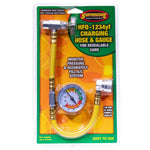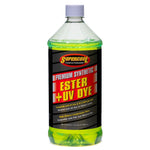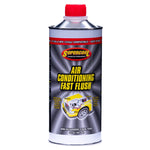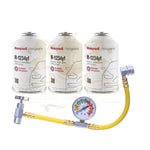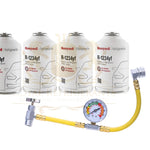You have no items in your shopping cart.
Understanding R-134a Refrigerant: Applications, Properties, and Environmental Impact
Introduction to R-134a
R-134a, or 1,1,1,2-Tetrafluoroethane, is a widely used refrigerant that has become the standard in various cooling and air-conditioning systems across industries. Since its introduction as an alternative to older, ozone-depleting refrigerants like R-12, R-134a has gained prominence for its effectiveness and safety. While R-134a significantly helped reduce the damage to the ozone layer, it is not without its environmental concerns, primarily due to its high Global Warming Potential (GWP).
In this article, we’ll explore the properties, applications, and environmental impact of R-134a, and look at the future of refrigerants as the world moves towards more sustainable options.
Chemical Properties of R-134a
R-134a is a colorless, non-flammable gas at room temperature, with a low boiling point of -26.3°C (-15.3°F). As a member of the hydrofluorocarbon (HFC) family, it contains no chlorine atoms, which makes it ozone-friendly compared to the CFCs it replaced.
Key properties of R-134a include:
-
Chemical formula: C₂H₂F₄
-
Molecular weight: 102.03 g/mol
-
Boiling point: -26.3°C (-15.3°F)
-
Appearance: Colorless, odorless gas
-
Thermal conductivity: Moderate
Its non-flammability and excellent thermodynamic properties make it highly suited for refrigeration systems, air conditioners, and heat pumps.

Applications of R-134a
R-134a is primarily used in air conditioning and refrigeration systems due to its effective heat-absorption capabilities. It is used both in automobiles and commercial equipment. Some of its most common applications include:
1. Automotive Air Conditioning
R-134a became the global standard refrigerant in car air conditioning systems after the phase-out of CFC-based R-12. Since then, it has been the go-to refrigerant for vehicle A/C systems because of its excellent heat exchange efficiency and non-ozone-depleting properties.
2. Refrigerators and Freezers
R-134a is widely used in domestic refrigerators, freezers, and vending machines. It efficiently removes heat, making it ideal for both household and commercial cooling systems.
3. Aerosol Propellants
R-134a is also used in some aerosol products, such as medical inhalers and certain cosmetic sprays, as a propellant. Its non-flammability makes it a safer alternative to other propellants, such as propane and butane.
4. Heat Pumps
In heat pumps and some chiller systems, R-134a plays an essential role in transferring heat in both heating and cooling processes, thanks to its favorable thermodynamic properties.
Environmental Impact of R-134a
Although R-134a is a significant improvement over older refrigerants like R-12, it is not without its environmental consequences. The primary concern with R-134a lies in its Global Warming Potential (GWP), which is around 1300—meaning that it contributes to climate change if released into the atmosphere. While R-134a has zero ozone depletion potential (ODP), its high GWP makes it a greenhouse gas.
Regulations and Phase-Out
In recent years, international agreements such as the Montreal Protocol and the Kigali Amendment have sought to reduce the use of high-GWP refrigerants like R-134a. These protocols are part of a global effort to curb climate change by encouraging the use of refrigerants with lower environmental impact.
The European Union has been particularly active in restricting the use of high-GWP refrigerants, while other regions are following suit, encouraging the development of alternatives that have minimal impact on both the ozone layer and global warming.
Alternatives to R-134a
Several low-GWP alternatives are emerging to replace R-134a, including:
-
R-1234yf: A low-GWP refrigerant that is being adopted for automotive air conditioning systems as a replacement for R-134a. Its GWP is around 4, which is much lower than that of R-134a.
-
CO₂ (R-744): Carbon dioxide is being explored as an environmentally friendly alternative for commercial refrigeration and heat pump systems, especially in supermarket cooling.
-
Hydrocarbons (e.g., R-290, R-600a): These natural refrigerants, such as propane (R-290) and isobutane (R-600a), offer low-GWP and are widely used in small refrigeration systems.
Safety and Handling of R-134a
R-134a is generally safe to handle in well-ventilated areas. However, certain precautions should be observed:
-
Frostbite Risk: Direct contact with liquid R-134a can cause frostbite due to its low boiling point.
-
Ventilation: In case of accidental release in a confined space, R-134a should be ventilated properly, as high concentrations may cause oxygen displacement.
-
Non-Flammability: R-134a is non-flammable under normal conditions, which is an advantage over older refrigerants like propane (R-290), but it can become reactive under extreme conditions (e.g., high temperatures or flame).
Future of Refrigerants
The refrigerant industry is undergoing a transformation, driven by both environmental regulations and technological advancements. The shift towards low-GWP refrigerants is accelerating, with a strong focus on natural refrigerants and synthetic options that provide both efficiency and environmental safety.
R-134a will continue to be used in many existing systems for years to come. However, its replacement with newer refrigerants, such as R-1234yf and CO₂, is expected to grow as the world seeks to combat climate change and reduce the harmful effects of high-GWP gases.
Conclusion
R-134a has been a key player in the refrigeration and air conditioning industries, offering a safer alternative to ozone-depleting substances. However, its high GWP poses a significant challenge for the environment. As demand grows for more sustainable and eco-friendly refrigerants, R-134a is being gradually phased out in favor of options that pose less of a threat to global warming. The evolution of refrigerants reflects the ongoing effort to balance industry needs with environmental responsibility.
 English
English

